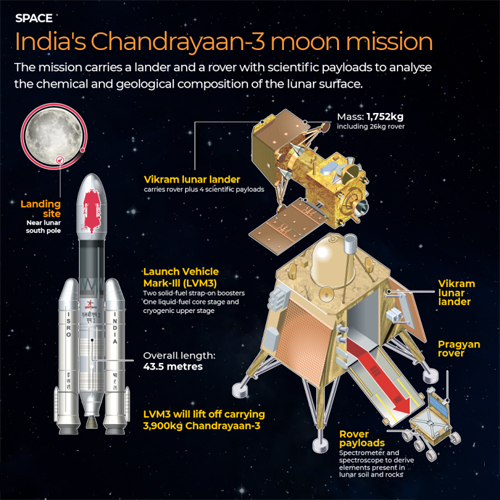
On July 14, 2023, the Indian Space Research Organisation (ISRO) successfully launched ‘Chandrayaan-3 (Moon Craft)’ spacecraft into orbit onboard Launch Vehicle Mark-3 Mission 4(LVM3 M4) rocket from SDSC SHAR (Satish Dhawan Space Centre- Sriharikota Range), Sriharikota, Andhra Pradesh (AP). Under the Chairmanship of ISRO Sreedhara Panicker Somanath.
- It is India’s third lunar exploration mission after Chandrayaan 1 in 2008, Chandrayaan 2 in 2019.
- LVM3 is responsible for placing the integrated module, comprising the propulsion module, the lander module, and the rover, in an Elliptic Parking Orbit (EPO) measuring 170 x 36,500 km.
- The Chandrayaan’s 3 mission director – Mohan Kumar, the Vehicle/Rocket Director – Biju C. Thomas and the Spacecraft Director – Dr P. Veeramuthuvel.
Note: The 642 tonne LVM 3 (formerly GSLV-Geosynchronous Satellite Launch Vehicle MkIII) is 43.5 metre tall rocket, and is nicknamed as ‘Bahubali’ or ‘Fat Boy’.
Highlights of Chandrayaan-3:
i.Developed by ISRO, it consists of indigenous Lander module (LM) called Vikram (Valour), Propulsion Module (PM) and Rover named Pragyaan (Wisdom) with an objective of developing and demonstrating new technologies required for Inter planetary missions.
ii.Objectives: To demonstrate Safe and Soft Landing on Lunar Surface, To demonstrate Rover roving on the moon and to conduct in-situ scientific experiments.
- In-situ is a Latin phrase meaning “in the original location”.
iii.The spacecraft will take nearly 42 days to reach moon.
iv.The Lander and rover are expected to land near the lunar south pole region on August 23 or 24, 2023.
v.With successful landing, India will be the first country to land spacecraft near Moon’s South Pole at 70 degrees latitude, and the 4th country to soft land on the moon after the United States (US) with its Surveyor 1 in 1966; Soviet Union/Russia’s Luna 9 in 1966, and China with Chang’s 3 in 2013.
vi.The mission life of Lander & Rover is One lunar day (~14 Earth days), and their Landing Site (Prime) is 4 km x 2.4 km 69.367621 S, 32.348126 E.
vii.The moon’s south pole region has been chosen because of a possibility of presence of water/ice molecules in the deep craters in this region. This was indicated by the Chandrayaan-1 mission.
- The presence of water ice that could support a future space station.
- Also, the conditions on this region of the Moon could hold clues about the early solar system and the history of Earth.

Highlights of Mission Sequence:
The Mission is classified into multiple phases which is broadly classified into three:
- Earth Centric Phase (Phase-1) which includes, Pre-launch Phase; Launch and Ascent Phase; and Earth-bound Manoeuvre Phase (orbit-raising manoeuvre).
- Lunar Transfer Phase (Phase-2) – the transfer trajectory phase.
- Moon Centric Phase which includes Lunar Orbit Insertion Phase (LOI)-(Phase-3); Moon-bound Manoeuvre Phase (Phase-4); PM and Lunar Module Separation (Phase-5) and others.
Key Points:
Earth-bound Manoeuvre Phase(orbit-raising manoeuvre) is performed by the ISRO Telemetry Tracking and Command Network (ISTRAC) in Bengaluru, Karnataka.
Four Earth-bound manoeuvres will be conducted till July 31 and the trans-lunar insertion will take place on August 1.
- The first orbit-raising manoeuvre was conducted on 15th July 2023 and placed the Chandrayaan-3 spacecraft at the 41,762 km x 173 km orbit (closest to Earth is at 173 km and farthest at 41,762 km).
- The 2nd orbit-raising manoeuvre (Earth-bound apogee firing) was performed on 17th July 2023 and the spacecraft is now in 41603 km x 226 km orbit.
- The 3rd orbit-raising manoeuvre (Earth-bound perigee firing) was performed on 18th July 2023 and the 4th manoeuvre is planned for 20th July 2023.
Outlay of Chandrayaan 3:
As per ISRO statements in 2020, its estimated cost is around Rs 615 crore or USD75 Million. Of that, the lander, rover and propulsion module cost Rs 250 crore and the launch services cost around Rs 365 crore.
- It is one of the most cost-effective space missions as compared to its predecessors.
Mass:
The total for Chandrayaan-3 is 3897.89 Kg consist of the following:
- Propulsion Module: 2148 kg
- Lander Module: 1752 kg including Rover of 26 kg
Click Here for full list of Specifications
Chandrayaan 3: A follow up Mission to Chandrayaan 2
It follow-up to the partially successful Chandrayaan-2 mission, whose lander Vikram and rover Pragyaan crashed on the Moon’s surface on September 7, 2019. It was expected to launch in 2021 but delayed amid COVID-19 Pandemic.
- Chandrayaan 3 mission is nearly identical to the Chandrayaan 2 mission, but the Orbiter component has been replaced with PM.
Details of Chandrayaan 3 Components:
Lander (Vikram):
It is box-shaped, with four landing legs and four landing thrusters of 800 newtons each unlike Vikram on Chandrayaan-2 which had five 800 Newtons engines with a fifth one being centrally mounted with a fixed thrust. Additionally, the Chandrayaan-3 lander will be equipped with a Laser Doppler Velocimeter (LDV).
- It have the capability to soft land at a specified lunar site and deploy the Rover which will carry out in-situ chemical analysis of the lunar surface during the course of its mobility. It consists of the following Payloads:
i.Radio Anatomy of Moon Bound Hypersensitive ionosphere and Atmosphere (RAMBHA) Langmuir Probe (LP) to estimate the plasma density and its variations
ii.Chandra’s Surface Thermophysical Experiment (ChaSTE) to measure the thermal conductivity and temperature
iii.Instrument for Lunar Seismic Activity (ILSA) for measuring the seismicity around the landing site
iv.Laser Retroreflector Array (LRA), a passive experiment, to understand the dynamics of Moon system.
Rover (Pragyaan):
The rover is a tiny, trolley kind of device with wheels. Once the lander lands on the moon, the rover will slide out of the lander’s belly and crawl over the moon’s surface like a cockroach. It will pick up soil and do experiments, punch a probe a foot down the surface to check thermal conductivity. Its payloads are:
i.Alpha Particle X-ray Spectrometer (APXS) to determine the elemental composition (Mg (Magnesium), Al (Aluminium), Si (Silicon), K (Potassium), Ca (Calcium), Ti (Titanium), Fe (Iron)) of Lunar soil and rocks around the lunar landing site.
ii.Laser Induced Breakdown Spectroscope (LIBS) for deriving the elemental composition in the vicinity of landing site.
Point to be noted: Both the Lander and the Rover instruments conduct experiments, such as analyzing the moon soil, checking how the moon’s surface conducts heat, and how quake waves move through the moon surface.
Propulsion Module (PM):
It is a replacement for orbiter (Chandrayaan 2). The main function of PM is to carry the Lander and the Rover from launch vehicle injection till final lunar 100 km circular polar orbit and make their separation from itself. Its payloads are:
i.Spectro-polarimetry of Habitable Planet Earth (SHAPE) to study the spectral and polarimetric measurements of Earth from the lunar orbit in the near-infrared (NIR) wavelength range (1-1.7 μm).
ii.It also has one scientific payload as a value addition which will be operated post separation of Lander Module.
ESA ground stations support Chandrayaan-3 Moon mission
According to the June 2021 agreement signed by the ESA and ISRO to provide technical support to each other, including tracking and communication services to upcoming Indian space missions through ESA’s ground stations.
- The European Space Tracking (ESTRACK) operated by European Space Agency (ESA) will support the mission
i.ESA’s 15 metre antenna in Kourou, French Guiana, will be used to track Chandrayaan-3 health status after its lift.
ii.32-metre antenna at Goonhilly Earth Station Ltd in the United Kingdom will track Chandrayaan-3’s propulsion and lander modules.
iii.Data and telemetry sent back by Chandrayaan-3 arriving via Kourou and Goonhilly will first be forwarded to ESOC. From there, they will be sent to ISRO for analysis.
iv.Additionally NASA’s Deep Space Network and ISRO’s two own stations (ISRO Spacecraft Command Centre and ISRO 32 metre Deep Space Antenna at Byalalu, Karnataka) will also track the Chandrayaan-3.
v.In June 2021, ESA and ISRO signed an agreement to provide technical support to each other, including tracking and communication services to upcoming Indian space missions through ESA’s ground stations.
Scientific experiments to be conducted by Chandrayaan 3:
i.Gather data on the polarization of light reflected by Earth
ii.Measure the density of ions and electrons near the surface of the Moon and its changes over time
iii.Measure the temperature of the moon’s surface near polar region
iv.Scan for moonquakes around landing site, delineating the structure of the lunar crust and mantle
v.Understand the dynamics of the Moon system
The Landing Process:
Chandrayaan 3’s landing process involves three stages: Earth orbit manoeuvres, Trans-lunar injection, and Lunar orbit manoeuvres. Once completed, the lander separates from the main spacecraft and performs a soft landing on the moon.
- Soft landing means decelerating from over 6,000 km/h to zero on the moon’s surface.
Key Points:
i.It travels a distance of 384,400 km, circling the Earth independently in an elliptical orbit. It orbits the Earth 5-6 times, ranging from 170 km to 36,500 km, before moving towards the lunar orbit.
ii.When the spacecraft is about 100 km from the moon, the lander detaches and begins its descent. It uses four thrusters to slow down its descent, reaching a speed of 2 meters per second before touchdown.
How does the data collected by the lander and rover reach the earth?
The data collected by the lander and rover is digitized and transmitted as electromagnetic waves to a receiver on the circulating PM around the moon. The orbiter module from the previous Chandrayaan-2 mission serves as a backup with its own receiver. Either the PM or the orbiter will transmit the data back to Earth.
Key Notes:
i.It should be noted that PM, the lander, the rover are all up there forever.
ii.As the moon completes a full rotation on its axis, approximately 29.5 Earth days pass. A moon day and night both last about 14 Earth days. Since the lander and rover rely on solar panels for electricity, they will remain operational for one moon day, equivalent to 14 Earth days.
Launch of Vinod Mankara’s ‘Prism: The Ancestral Abode of Rainbow’
National award-winning filmmaker-writer Vinod Mankara’s new book titled ‘Prism: The Ancestral Abode of Rainbow’ was also released from the rocket launchpad at SDSC.
- It was released by ISRO Chairman Sreedhara Panicker Somanath and handed over to Vikram Sarabhai Space Centre (VSSC) Director S Unnikrishnan Nair.
Key Points:
i.It is published by Kozhikode (Kerala)-based Lipi Publications.
ii.It is a collection of 50 interesting articles from various streams of science including space science, astronomy, biology, anthropology and mathematics. It covers various topics such as the James Webb space telescope, dark sky tourism, black hole confirmation, the dog Laika’s first space journey, etc.
iii.It is an exploration into the aesthetic and poetic aspects of science.
ISRO Chairman unveils vital facilities for Solid Motor Advancement
On July 12, 2023, a group of vital facilities essential for the enhancement of solid motor realization were inaugurated by Indian Space Research Organisation (ISRO) Chairman Sreedhara Panicker Somanath from SDSC SHAR (Satish Dhawan Space Centre- Sriharikota Range), Sriharikota, Andhra Pradesh (AP).
- SDSC-SHAR is responsible for the development of solid motors/ segments for ISRO’s acclaimed launch vehicles. Now, it aims to set up 29 primary and 16 auxiliary facilities to enhance its capabilities in solid propellant processing.
- This inauguration is the first phase of this initiative by introducing five key facilities dedicated to solid propellant mixing, casting, machining, and non-destructive testing of cast segments.
About Indian Space Research Organisation (ISRO):
Chairman– S. Somanath
Headquarters– Bengaluru, Karnataka
Establishment– 1969




